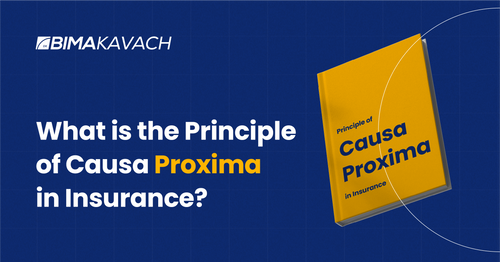Insurance, a fundamental pillar of modern society, provides individuals and businesses with financial security in the face of unforeseen events. From protecting homes against natural disasters to safeguarding businesses from liability claims, insurance plays a crucial role in mitigating risks and ensuring stability. At the heart of this intricate system lies a fundamental principle that serves as the guiding light for insurers and policyholders alike—the principle of Causa Proxima.
In this article, we would look into this principle and its significance in the realm of insurance. We will explore its historical development, its application in various insurance types, and the impact it has on both policyholders and insurers. Furthermore, we will highlight relevant examples to highlight the practical implications of this principle and shed light on its role in settling claims.
Let’s get going then!
The Principle of Causa Proxima
Derived from Latin, “Causa Proxima” translates to "nearest cause" and forms the bedrock of insurance claims assessment. It embodies the essence of determining the actual cause of an event, thereby establishing the legitimacy of a claim. By understanding and applying this principle, insurers can assess the circumstances surrounding an incident accurately and determine the extent of coverage provided under the policy.
Get Free Quote in Minutes
When an insured event occurs, it is essential to ascertain the cause or series of events that led to the loss. The Principle of Causa Proxima helps insurers assess the circumstances surrounding the incident and identify the most immediate or proximate cause. It recognizes that an event can have multiple causes, some of which may be covered by the insurance policy, while others may not. It aims to distinguish between the proximate cause, the event that directly and immediately leads to the loss, and any remote or indirect causes that may have contributed to the event but are not the primary reason for the loss.
Please keep in mind that the proximate cause is not always the first or last cause; it is the efficient, dominant, or operative cause. When determining the insurer's liability, only the proximate (nearest) cause should be considered, not the remote cause. Even if the remote cause is one of the insured perils, the insurer is not liable. If the immediate cause is an insured risk for the occurrence of which the insured is to be compensated, the insurer is obligated to provide the payment under the policy; otherwise, the insurer is not.
Examples of the application of the Principle of Causa Proxima in Commercial Insurance
Here are 2 examples of the application of the Principle of Causa Proxima in Commercial Insurance-
Example 1:
M/S ABC Careers has purchased a marine cargo insurance policy to cover the goods they export. Under the policy, the goods have been insured against damage caused by seawater. A hole formed at the ship's bottom during the cruise. Sea water entered the ship through this hole, causing damage to the insured items.
In this scenario, the mishap had two causes. The first was the hole in the ship's bottom and the second was the seepage of seawater into the ship. The seepage of water is the closest cause of the damage to the goods, while the hole in the ship's bottom is the remote cause. As a result, M/S ABC Careers must be reimbursed for the loss incurred as a result of damaged items covered by the policy.
Example 2:
M/S XYZ Enterprise, a manufacturing company, has purchased a Business Interruption Insurance policy. Let us consider it experiences a fire in its warehouse, resulting in significant damage to its stock. As a result, the company is forced to halt production for several weeks. While the fire is the immediate cause of the physical damage, it is the resulting business interruption that triggers the insurance claim. In this scenario, the insurer would apply the Principle of Causa Proxima to establish a causal connection between the fire (the covered peril) and the subsequent business interruption. It would consider factors such as the extent of the damage, the time required for restoration and the impact on the company's revenue and profitability. By analyzing the proximate cause, the insurer can determine the eligibility and extent of coverage under the Business Interruption Insurance policy.

Advantages of the application of the Principle of Causa Proxima in Commercial Insurance
The application of the Principle of Causa Proxima in commercial insurance offers several advantages for both insurers and policyholders. Here are some key benefits:
- Helps in Objective Evaluation of Claims: The Principle of Causa Proxima provides a clear framework for insurers to objectively evaluate claims. By focusing on the closest or most immediate cause of the loss, insurers can avoid disputes and make fair assessments based on the actual circumstances surrounding the event. This helps maintain transparency and consistency in claim settlement processes.
- Accurate Coverage Determination: The Principle of Causa Proxima enables insurers to accurately determine the coverage applicable to a specific event. By identifying the proximate cause, insurers can assess whether the event falls within the scope of coverage outlined in the policy. This ensures that policyholders receive the appropriate compensation for covered losses while minimizing the potential for fraudulent or unjust claims.
- Risk Assessment and Premium Calculation: Insurers utilize the Principle of Causa Proxima during the risk assessment process to determine the likelihood and severity of potential losses. By analyzing the proximate causes of past events and their impact, insurers can better estimate the risk associated with specific perils and adjust premiums accordingly. This helps maintain a fair pricing structure that aligns with the level of risk assumed by the insurer.
- Prevention of Moral Hazard: The Principle of Causa Proxima acts as a deterrent against moral hazard, which refers to the increased likelihood of policyholders taking risks or being negligent if they believe they will be fully compensated regardless of their actions. By assessing claims based on the proximate cause, insurers discourage policyholders from engaging in risky behavior and promote responsible risk management practices.
- Clarity in Coverage Interpretation: The Principle of Causa Proxima provides clarity in the interpretation of insurance policies. It helps policyholders understand the specific events and perils covered under their policies, as well as any exclusions or limitations. This transparency allows policyholders to make informed decisions when selecting coverage and ensures that they have a clear understanding of the risks they are protected against.
- Industry Consistency and Standards: The application of the Principle of Causa Proxima contributes to consistency and standardization within the insurance industry. By adhering to this principle, insurers ensure a uniform approach to claim assessment and settlement. This promotes trust and confidence among policyholders, as they can expect similar treatment and outcomes when filing claims with different insurers.
The footnote:
From the discussion above, we have seen that the Principle of Causa Proxima stands as a cornerstone of the insurance industry, guiding insurers and policyholders in the evaluation of claims, coverage determination, and risk assessment. Through a comprehensive understanding of the proximate cause—the closest or most immediate cause of an event—this principle ensures fairness, transparency, and consistency in the realm of insurance.
As the insurance landscape continues to evolve, the Principle of Causa Proxima remains an essential guidepost, instilling trust and confidence in policyholders. It upholds the fundamental principles of fairness, transparency, and stability, allowing individuals and businesses to navigate the complex realm of insurance with clarity and peace of mind. By understanding and embracing this principle, we can fortify the foundation of insurance, empowering individuals and organizations to face the future with confidence and resilience.

